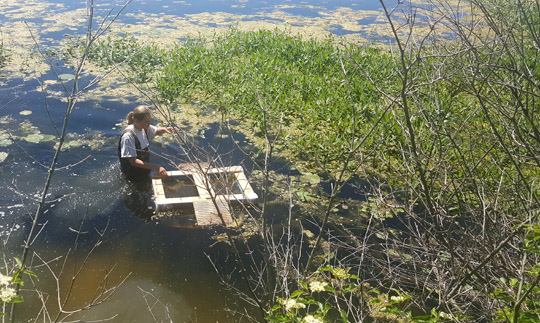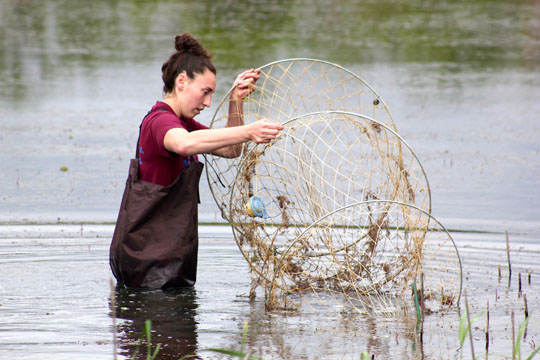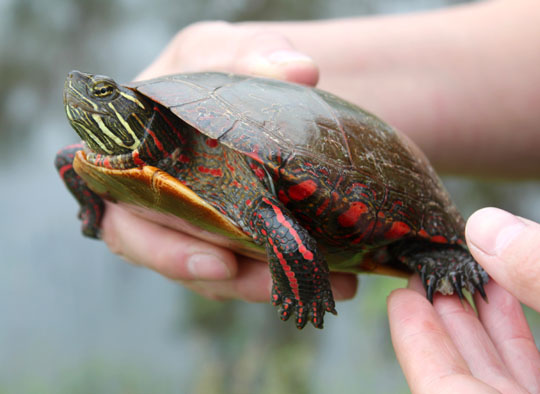When the tap water of more than 500,000 northwest Ohioans was declared unsafe in August 2014, the three-day crisis caused global concern. Most was focused on how high levels of microcystin in citizens’ Lake Erie-fed tap water could affect those using it to drink, cook and bathe.
There was scant discussion regarding how the toxin, which is caused by certain freshwater cyanobacteria found in algal blooms, affects wildlife in and around freshwater lakes such as Lake Erie because little research existed.

This painted turtle from the Ottawa National Wildlife Refuge in Oak Harbor, Ohio, was trapped and released by Dr. Jeanine Refsnider and her assistants after they took measurements to assess the effects of algal blooms on the reptile.
“Turtles are quite robust,” Refsnider said. “For a lot of species of vertebrates, what you see is when they’re stressed, their immune function is depressed, just like you find in humans. For turtles, preliminarily, we don’t really see that. [Their] immune system doesn’t seem to get weaker when they’re under stress.”
Refsnider and her team have been trapping turtles at Ottawa National Wildlife Refuge in Oak Harbor, Ohio, since mid-May and will continue through next month. In the field, they take baseline measurements, such as weight and size; determine the genders; check females for eggs; count the number of leeches clinging to shells; and photograph the shells.

Dr. Jeanine Refsnider set up a trap to catch turtles at the Ottawa National Wildlife Refuge in Oak Harbor, Ohio. The turtles are not harmed by the tests performed in the lab or field, she said.
The team also will take blood samples from each turtle’s tail for various assays to be examined in Refsnider’s lab.
“We’re looking for baseline levels of physiological stress,” she said. “When an organism is exposed to a longer-term stressor, the ratio of different types of white blood cells changes. It takes a few days, but you can actually get an estimate of their stress level by counting the number of white blood cells and looking at this ratio.
“We’re expecting that turtles during an algal bloom will have higher stress levels and lower immune functioning than turtles that are not exposed to an algal bloom, or turtles from different years when there isn’t any exposure to algae.”

Jessica Garcia, a graduate student pursuing a master’s degree in biology, walked a painted turtle to the water at the Ottawa National Wildlife Refuge in Oak Harbor, Ohio.
According to the National Oceanic and Atmospheric Administration, spring measurements and rainfall projections indicate that the formation of harmful algal blooms this summer will be in the “middle of the pack” — neither severe nor insignificant.
Since Lake Erie is the shallowest and warmest of the Great Lakes, it is most susceptible to algal bloom formation.
Refsnider said this year she’d like to sample about 80 turtles, including painted turtles, which are the most common to be seen basking on rocks and other structures; map turtles, which live closer to streams and rivers; snapping turtles; and red-eared slider turtles, which are not indigenous to Lake Erie, but are bought in pet stores and sometimes released into the wild.Map turtles will be subject to an additional assay that takes place during 48 hours in Refsnider’s lab.
“We inject a skin irritant in the webbing between their toes that causes their body to think it’s infected, so the skin swells a little bit,” Refsnider said. “It is similar to the response to a bacterial infection. We can measure how much their skin swells in response to that irritant. It usually peaks at about six hours, then goes back to normal within the next 36 hours.”

Jessica Garcia checked a net for turtles at the Ottawa National Wildlife Refuge in Oak Harbor, Ohio.
None of the turtles, she added, are harmed by tests performed in the field or the lab.
Refsnider expects turtle research to be a precursor for further studies among Lake Erie’s wildlife, including water snakes, frogs and water birds.
“Since turtles are pretty tough, you can expose them to new climates and it doesn’t seem to affect them too much,” Refsnider, who has conducted research on turtles previously, said. “But a toxin in their water might be a substantially bigger problem; we’re just not sure. It could be that it doesn’t affect turtles, but it affects snakes or birds.”
She said water snakes at the Ottawa refuge are similar to the indigenous Lake Erie water snakes found only around the limestone islands scattered near the Catawba/Marblehead peninsula in Catawba Island, Ohio.
 “The snake we’ll be studying is closely related to the Lake Erie water snake, and there are two rare turtle species that live along Lake Erie,” Refsnider said. “Whatever impact algal blooms have on these common species, they’re going to have on the rare species because both are closely related, so this will have implications on the endangered species.”
“The snake we’ll be studying is closely related to the Lake Erie water snake, and there are two rare turtle species that live along Lake Erie,” Refsnider said. “Whatever impact algal blooms have on these common species, they’re going to have on the rare species because both are closely related, so this will have implications on the endangered species.”
At UT since 2015, Refsnider was drawn by the opportunity to study how organisms respond to rapid environmental change. The ecological climate surrounding Lake Erie seemed an ideal laboratory.
“The ecology here is really interesting,” Refsnider said. “For the Midwest, Ohio has a really diverse community of reptiles and amphibians, which is what I work on. This is a great fit for me.”
She hopes research that begins with 80 turtles will have broader applications as scientists grapple with the effects of unprecedented climate change.
“If we can tell that algal blooms have a severe impact on these populations, maybe we can think about how to protect certain habitat areas from any kind of water exchange with Lake Erie so they have a refuge,” Refsnider noted. “Understanding the role algal blooms play in the decline of a local species will give us a better idea of how to protect these species against some human-caused threats.”